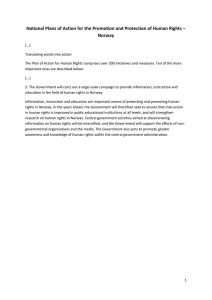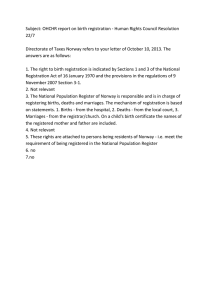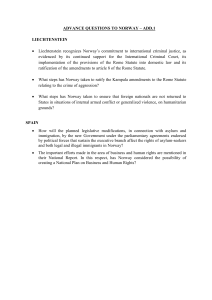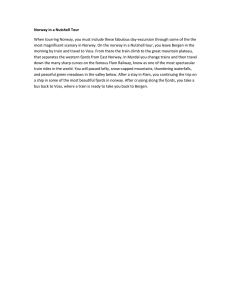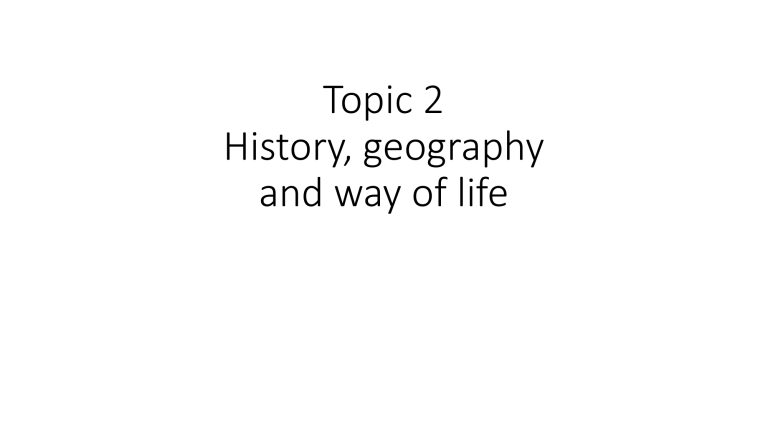
Topic 2 History, geography and way of life Topics for today: • Brief history • Facts and figures • The Sami people Discuss: • What do you know about the history of Norway? • Why is it important to know a country’s history? • How does Norway’s history affect present-day Norway? Ca 800-1050 AD The viking age • Lasted for 300 years • Harald Hårfagre (the first king of Norway) united Norway into one kingdom • Explored and settled new land • Nordic mythology • Brought with them Christianity 1397-1814 Union with Denmark • Lasted for 400 years • Norway ruled by a Danish king • Official language-Danish 1814-1905 • Union with Sweden (100 years) • After the Napoleon wars in Europe, Norway was handed over to Sweden • Norway drafted its own constitution on 17 May 1814 (112 representatives) • The Storting, the Norwegian parliament was established • Swedish king 1850National romanticism • Building a Norwegian identity • expressed in literature, visual arts and music Discuss! • In the 1800s, many Norwegians felt a strong sense of national pride. • What is national pride? • What creates national pride? • What are possible negative and positive aspects of national pride? Industrialisation of Norway • around 70 percent of the Norwegian population lived in rural areas (before 1850) • agriculture and fishing • population increased-not enough land • people moved from the countryside to the cities • Emigration to the United States (1850-1920) The labour movement fought for better conditions for workers, e.g • shorter working days • better safety conditions in the workplace • health insurance • right to financial support when unemployed 1913- both men and women had the right to vote Discuss! • Talk about how the labour movement has affected present-day Norway. 1905 • Union with Sweden dissolved • Norway becomes independent • Prince Carl elected King of Norway: King Haakon VII (1905-1957). • Industrial revolution (end of 18 th century) • Norway began using hydroelectric power to produce electricity (at the end of the 1800s) 1939-1940 World war II • Norway occupied for five years • Germany capitulated on 8 May 1945 • Around 9,500 Norwegians died • The king and the government escaped to London • Around 50,000 Norwegians fled to Sweden during the Second World War • resistance groups-sabotage, illegal newspapers Post war period • Rebuilding the country after the war • Norway accepted the Marshall Plan from The United States • Optimism in the population • Einar Gerhardsen, Norway’s prime minister and one of the founders of the Norwegian welfare state 1960S The oil age • 1969- oil was found in the North sea • Today, Norway is one of the countries in the world that exports the most oil • significant impact on the Norwegian economy The Norwegian monarchy • The head of state in a monarchy is a king or queen • Norway is a constitutional monarchy. which means that the king has little political power • The monarch (king/queen) is not elected by the people in a political election. The title is passed down from parent to child. • The current King of Norway is Harald the 5th The Norwegian Royal Family The king of Norway www.kongehuset.no • King Harald’s speech in Slottsparken September 2016: https://www.theguardian.com/wo rld/2016/sep/06/king-haraldnorway-diversity-speech Questions for discussion • Is this speech of the kind you would expect from a monarch? Why/Why not? • What does this speech tell you about the Norwegian society? • Discuss the message of the King’s speech. • What does it mean when it says «Norway is its people»? • Find some examples of how the speech address issues as immigration, equality and diversity. • Why do you think this speech has gone viral? • What do you think about the speech? Settlement and population in Norway • The population of Norway is around five million. • Almost 75 % of inhabitants live along the coast. • Around 50 %of the population lives in Eastern Norway. • Around 12% of the population has an immigrant background (immigrants and Norway-born children of immigrants). Oslo and Drammen -the highest percentage of inhabitants with an immigrant background. Key figures Population (SSB) https://www.ssb.no/en/befolkning/nokkeltall/population The five regions of Norway • Northern Norway • Trøndelag (Midt-Norge) • Western Norway • Southern Norway • Eastern Norway NORWAY 50% mountains 38% percent forest 3% cultivated land • Long and narrow country • Long coastline • Numerous fjords along the coast • 19 counties and 428 municipalities. 100 cities • Discuss: INTRO 16-19 https://www.youtube.com/watch?v=BPa8kVT5_t8 Sandnes • the 8th largest city in Norway south of the city of Stavanger, the 4th largest city in Norway. Together, the Stavanger/Sandnes area is the 3rd largest urban area in Norway. Coat-of-arms • The arms show a white piece of pottery on a green background. Pottery was one of the main industries in the late 18th century. The symbol is a leirgauk, a simple flute which was made by the potteries in Sandnes. Later Sandnesgauk also became a nickname for people from Sandnes.[ The Sami people • • • • • • • • The indigenous population of Norway The Sami people live in four countries: Norway, Sweden, Finland and Russia Between 40,000 and 50,000 Sami live in Norway today. Around 2,600 Sami people in Norway make their living from herding reindeer The Sami have their own language called Sami. There are many different variants of the Sami language. Around 50,000 Sami also live in Sweden, Finland and Russia The Sami have had their own Sami Parliament (Sameting) since 1989. Today, a large proportion of the Sami people live outside the traditional Sami areas and have moved into the towns of Northern Norway or to the Oslo area. • https://www.youtube.com/watch?v=ZZIU7KEis3w http://www.oecdbetterlifeindex.org/countries/ norway/ Indigenous populations • INTRO p. 38 • 20 and 21 The Norwegian climate • The climate is much milder in Norway than in many other northern areas of the world. (mild ocean currents from the Gulf of Mexico in Central America) • The climate in Norway varies from area to area • the coastal areas: mild winter with little snow • the inland areas: cold winters with lots of snow. Warm and dry summers • Western Norway has more rain than Eastern Norway • Often very windy along the coast The seasons • Norway has four seasons: spring, summer, autumn and winter. • In Northern Norway, the winters are long, cold and dark. • The summers are short, but light, because of the Midnight Sun. • Inland areas: A lot of snow in winter • Coastal areas: little snow • More rain in Western Norway than in Eastern Norway • Stormy autumns along the coast Discuss • Intro 22-23 p. 38 • 24-27 • 28-31 The Norwegian climate The climate is much milder in Norway than in many other northern areas of the world. (mild ocean currents from the Gulf of Mexico in Central America) Regional differences • The climate in Norway varies from area to area • the coastal areas: mild winter with little snow • the inland areas: cold winters with lots of snow. Warm and dry summers • Western Norway has more rain than Eastern Norway • Often very windy along the coast Natural penomena in Northern Norway Midnight sun • a natural phenomenon in which the sun is above the horizon at midnight Polar nights • The opposite phenomenon, occurs in winter, when the sun stays below the horizon throughout the day. • Northern lights The seasons in Norway The seasons • Norway has four seasons: spring, summer, autumn and winter. • In Northern Norway, the winters are long, cold and dark. • The summers are short, but light, because of the Midnight Sun. • Inland areas: A lot of snow in winter • Coastal areas: little snow • More rain in Western Norway than in Eastern Norway • Stormy autumns along the coast Red letter days • 1. January: 1 New Year’s Day. • 8. March: International Women’s Day. • In March / April: Easter. • 40 days after Easter: Ascension • 50 days after Easter: Pentecost. • 1. May: International Workers’ day • 17. May: Norway’s national day. • 24. December: Christmas Eve. • 31. December: New Year’s Eve Religion in Norway • Early Norwegians believed in Norse mythology and worshipped many different gods • Christianity was introduced to Norway around 1,000 years ago • since the Reformation in the 1500s, Lutheran Christianity (Protestantism) has been the dominant religion in Norway. • about 80% of the population belong to the established Church of Norway The status of the church of Norway today • The Norwegian Church is a National church. It is the largest religious community in Norway, and practicing Lutheran-Protestant Christianity. • Previously, the Norwegian Church was the state church in Norway. • From May 2012, the state and the church were separated. The government no longer appoints bishops, priests, and church clerks, although church staff are still considered public employees. • There no longer a state religion in Norway, however the state will be built upon ‘our Christian and humanistic heritage’. • The royal family will still be required to belong to the Evangelical Lutheran Church. http://www.ssb.no/en/kultur-og-fritid/statistikker/kirke_kostra Full freedom of religion Discuss: • What does “freedom of religion” mean? • Do you have any examples when the principals of freedom of religion are challenged? • What do you think about the fact that the Norwegian society is becoming more and more secular (religion has become less important) • What do you think are the reasons for this? Full freedom of religion • the right of individuals to choose, change, and practice their religion. Different religious and spiritual groups in Norway • Around 20 percent of the Norway population does not belong to the state church. • Approximately half of these people are members of other religious or spiritual communities, while the other half does not belong to any such group. The ten percent that belong to a religious or spiritual group outside the Church of Norway are divided as follows: Equality • One of the most important values in Norwegian society • The Norwegian laws are largely based on the principle of equality between people, regardless of: gender, age, ability, cultural background, ethnic original or sexual orientation Discuss: How do you think the value of equality is reflected in society and in people’s lives?
